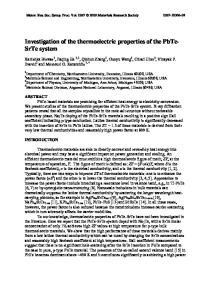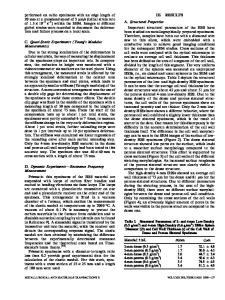Investigation into the thermoelectric properties of GaSb/InAs superlattice structures
- PDF / 240,481 Bytes
- 6 Pages / 432 x 648 pts Page_size
- 101 Downloads / 348 Views
Investigation into the thermoelectric properties of GaSb/InAs superlattice structures Philip T. Barletta1, Gary E. Bulman1, Geza Dezsi1, Thomas S. Colpitts1, and Rama Venkatasubramanian1 1
Center for Solid-State Energetics, RTI International, Research Triangle Park, 27706, U.S.A.
ABSTRACT We report on our investigation into the use of III-V superlattice structures for thermoelectric (TE) applications. Preliminary review of III-V materials trends indicate that the GaSb/InAs superlattice system should offer one of the best potentials for high thermoelectric performance in the 500K-800K range. MOCVD growth of GaSb/InAs superlattice structures was carried out, and relevant structural, thermal, and electrical characterization has been performed. TEM and XRD results demonstrate a well-ordered superlattice structure. Thermal conductivity measurements reveal a reduction in the room-temperature thermal conductivity of GaSb/InAs superlattices (4.4-10.0 W/m-K), relative to either binary GaSb (32 W/m-K) or InAs (27 W/m-K). Additionally, we have worked to optimize the thermoelectric power factor ( 2σ), studying both Se- and Te-doping of the superlattice structures, in an effort to demonstrate optimal thermoelectric performance. Our results demonstrate a maximum ZT of 0.36 at 400K for optimally doped n-type GaSb/InAs superlattice structures. INTRODUCTION The suitability of III-V material system for a number of applications (including LED’s [1,2], power devices [3], photovoltaics [4,5], and infrared detection [6,7]) has been wellestablished. However, there have been far fewer reports [8] on the study of III-V materials for thermoelectric (TE) applications. In the current work, we will report on our study of the TE properties of a specific III-V material system; i.e. the GaSb/InAs superlattice (SL) system. The determination of which III-V material has the best potential for highest thermoelectric figure of merit, ZT [9], can be inferred by examining periodic trends of the III-V materials system. Such an examination indicates that the III-Vs with the highest lattice constants would be the best candidates for TE applications for several reasons. First, thermal conductivity in III-Vs always decreases with lattice constant. Second, for a given pseudo-binary III-V alloy system, electron mobility always increases with lattice constant. Third, relatively small bandgaps are optimal for thermoelectric materials; i.e., the band gap (Eg) of the material should not be less than 6kT [10], where k is the Boltzmann constant and T is the operating temperature (in K). This means, for operation in the 500K-800K range, Eg should be ~0.26-0.41 eV. Based on these trends, the most promising candidates for III-V TE materials appear to be the GaInAsSb family of alloys. These alloys are characterized by large lattice constants (a=6.066.48 Å, the highest among all III-Vs), low bandgaps (0.18-0.7 eV), and the highest electron mobilities among all semiconductors [11]. In particular, the lower band gap III-V materials (i.e., GaSb and InAs) offer several adva
Data Loading...









